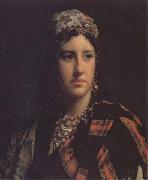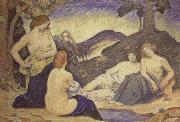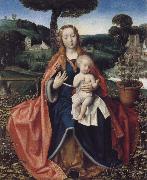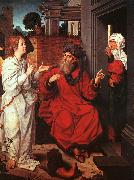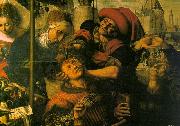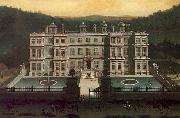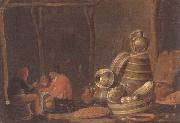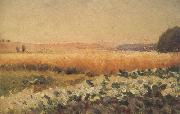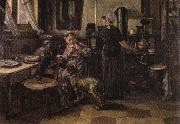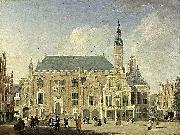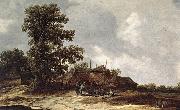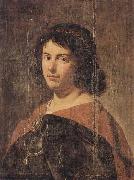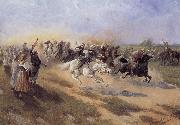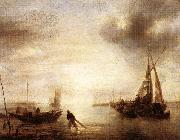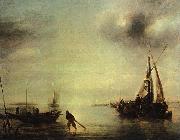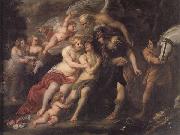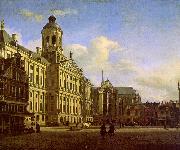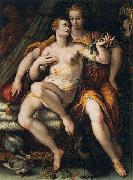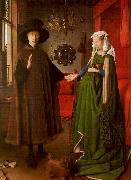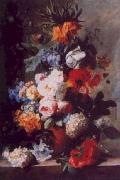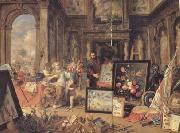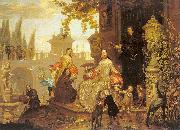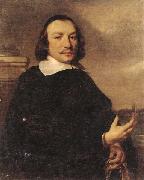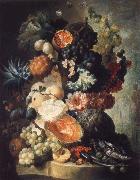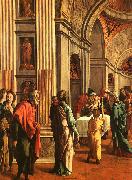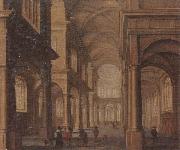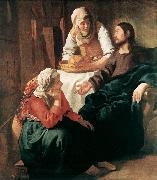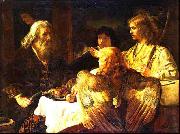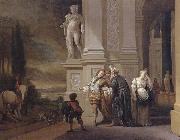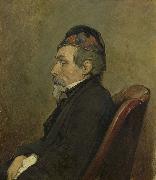|
|
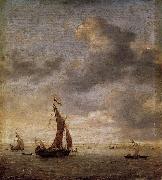 |
Jan Porcellis
|
|
(1583/5 - 29 January 1632) was a Dutch marine artist.
Porcellis was born in Ghent. He was the father of the marine artist Julius Porcellis (they shared a similar repertoire of subjects and an identical signature monogram), and is generally agreed to be the more fluent artist, particularly in his sense of space and his tonal palette (subtler than his son's). He died at Zoeterwoude.
|
|
|
|
|
|
|
|
|
|
|
|
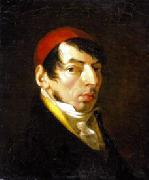 |
Jan Rustem
|
|
(b. 1762 in Istanbul - d. 1835 near Dekštas, Lithuania) was a painter of Armenian, Turkish or Greek ethnicity who lived and worked in the territories of the Polish CLithuanian Commonwealth. Primarily a portrait painter, he was commissioned to execute portraits of notable personalities of his epoch. For many years he was a professor at the University of Vilna, the predecessor of Vilnius University.
He was born in Instanbul, and a young boy was sponsored by Adam Kazimierz Czartoryski who invited him to the Commonwealth around 1774. Czartoryski paid for his studies in Warsaw, where among his tutors were Jean-Pierre Norblin de La Gourdaine and Marcello Bacciarelli. Between 1788 and 1790 he moved to Germany, where he became a freemason. Two years later he returned to the Polish - Lithuanian Commonwealth and lived for some time in Warsaw, later moving to Vilna.
Following the partitions of the Commonwealth, Rustem started working for the Common School of Vilna, which was later remamed the Imperial University of Vilna, as assistant to Franciszek Smuglewicz. After Smuglewicz's death, Rustem took over some of his duties. In 1811 he became a professor of sketching and in 1819 became a professor of painting. Rustem retired in 1826, but continued to give lectures until his death. |
|
|
|
|
|
|
|
|
|
Jan Stanisławski
|
|
(June 24, 1860, Olshana near Korsun - January 6, 1907, Krakew) was a Polish modernist painter, art professor, originator and member of various art groups and societies.
Initially, he studied mathematics at Warsaw University (1879 - 1882), and subsequently at the Imperial Technical Institute in St Petersburg.
He began to learn painting in the so called Drawing Class (which later gave rise to the School of Fine Arts) in Warsaw under Wojciech Gerson. In 1883, he enrolled in the School of Fine Arts in Krakew. In 1885, he continued his studies in Paris under Charles Emile Auguste Durand. While based in Paris, he travelled much, visiting Italy, Spain, Switzerland, Germany, Austria, and also Ukraine.
His early works were exhibited at the inauguration of the Salon du Champ-de-Mars in Paris in 1890 and at the Friends of the Arts Society in Krakew in 1892. In the 1890s, he travelled extensively and his sketchbooks filled up with drawings from Berlin, Dresden, Prague, Krakew, and various places in Ukraine. Together with Julian Fałat, he painted the landscape parts of Napoleones Army Crossing the Berezina, a panorama by Wojciech Kossak.
In 1897, he initiated and helped organise the Separate Exhibition of Pictures and Sculptures at Krakewes Cloth Hall. That year, he become a teacher of landscape painting at the School of Fine Arts in Krakew, and in 1906 - after the school was upgraded to an academy in 1900 - was granted full professorship and also taught at Teodor Axentowiczes Private School of Painting and Drawing for Women and at Teofila Certowiczes Art School for Women in Krakew.
He co-founded the "Sztuka" ("Art") Society of Polish Artists in Krakew in 1897. Later he became Deputy Chairman and finally Chairman of that society, and showed his works at numerous exhibitions organised by it. In 1898, he became a member of the Viennese Secession, and his works were exhibited among theirs in 1901, 1902 and 1905. In 1901, he became a founding member of the Polish Applied Arts Society. He worked in the Wawel Castle Reconstruction Committee and was involved in the activities of the Green Balloon (Zielony Balonik) Cabaret.
After his death, two exhibitions were opened at the Palace of Art in Krakew in November 1907, one to show 154 of his oil paintings, as well as drawings and watercolours, and the other to present the works of his numerous outstanding students.
|
|
|
|
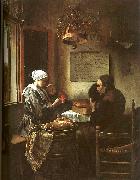 |
Jan Steen
|
|
Dutch Baroque Era Painter, ca.1625-1679 |
|
|
|
|
|
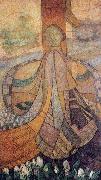 |
Jan Thorn-Prikker
|
|
(June 5, 1868, The Hague - March 5, 1932, Cologne) was a Dutch painter and designer in the Art Nouveau style. He was an important figure in religious art, best known for his stained glass windows. His most famous painting is the mystical The Bride (1893), in the Kroller-Muller Museum, Otterlo.
|
|
|
|
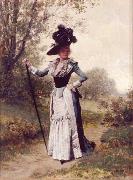 |
Jan van Beers
|
|
(22 February 1821 - 14 November 1888) was Flemish poet born in Antwerp. He is usually referred to as "van Beers the elder" to distinguish him from his son, Jan van Beers, the painter.
Van Beers was essentially a Netherlander, though politically a Belgian, expressing his thoughts in the same language as any North Netherland writer. In fact, the poems of Jan van Beers are perhaps more popular in the Netherlands than in Belgium, and of many of them there exist more editions printed in the Netherlands than in his political fatherland.
Van Beers started life as a teacher of Dutch language and literature, first at Mechelen, then at Lier, and in 1860 was appointed a professor of both at the Athenaeum (high school) in Antwerp, where he had also been a sub-librarian in the communal library. Van Beers as a teacher was early in the field, with Hendrik Conscience, Willems and others, when the Flemish movement began. He composed a Dutch grammar (1852), which, in enlarged editions, still holds the field, and a volume of selections from Dutch authors, both books being so much appreciated that the Belgian government made them text-books in the public schools.
Van Beers's historical poems, the principal of which is, perhaps, Jakob Van Maerlant (Amsterdam, 1860), helped the Flemish revival in Belgium as powerfully as his school-books. He is best known, however, as the writer of ballads and songs. Jongelingsdroomen ("A Young Man's Dreams") first appeared at Antwerp and Amsterdam in 1853. These poems were followed by Levensbeelden ("Life Figures or Pictures," Amsterdam, 1858) and by Gevoel en Leven ("Feeling Living," Amsterdam, 1869). His Rijzende Blaren ("Rising Leaves") first made its appearance at Ghent and Rotterdam in 1883. |
|
|
|
|
|
|
|
|
|
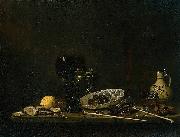 |
Jan van de Velde
|
|
(1593, Delft or Rotterdam-ca. 1 November 1641, Enkhuizen) was a Dutch Golden Age painter and engraver of animal, landscape and still-life subjects. He was the father of the still life painter Jan Jansz van de Velde.
He was apprenticed to engraver Jacob Matham in 1613, entered the Haarlem guild in 1614, and then probably visited Italy. He is better known for his etching and engraving than for his painting. According to Houbraken, he was the brother of Esaias van de Velde and Willem van de Velde the Elder, but according to John Denison Champlin, Esaias was his cousin, and he was no relation at all to the family of Willem. |
|
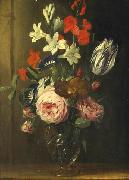 |
Jan van den Hecke
|
|
(1620-1684) was a Flemish Baroque painter.
According to Houbraken he painted landscapes, which he populated with animals and other figures himself. He also made flower and fruit still lifes and could paint gold, silver, crystal, and porcelain quite well. He spent a long period travelling and working in Italy, which is noticeable in his landscapes.
According to the RKD he was registered in the Antwerp Guild of Saint Luke as an apprentice in 1636 and learned to paint from Abraham Hack, who also taught his contemporary, the flower painter Hieronymus Galle. In 1641 Van den Hecke was registered as a master of the guild. From 1653-1658 he was in Italy, but somewhere in the mid-50's he went back and forth to Belgium, since he is also registered in Brussels during that period. He died the same year as his wife Maria Adriana Heijens; when they died they left three children; Jan (II), aged 24, Maria, aged 21, and Peeter, aged 20. Van den Hecke's pupil Peeter de Clerc eventually became a master painter in the guild. Van den Hecke's son Jan van den Hecke II became a popular flower painter. |
|
|
|
|
|
|
|
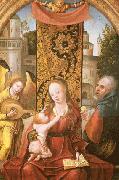 |
Jan Van Dornicke
|
|
was a South Netherlandish painter who was born about 1470 and died about 1527. His first name is sometimes spelled Janssone, and his last name is sometimes spelled van Doornik or van Dornick. He was active in Antwerp from about 1509 to about 1525. His paintings are classified stylistically as Antwerp Mannerism, and he may be the same person as the Master of 1518. |
|
|
|
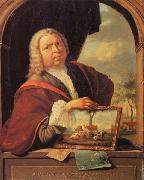 |
Jan van Gool
|
|
Johan, or Jan van Gool (1685 - 1763) was a Dutch painter and writer from The Hague, now remembered mainly as a biographer of artists from the Dutch Golden Age.
According to the RKD he learned to paint from Simon van der Does and Mattheus Terwesten. He became a member of the Confrerie Pictura in 1711. He was first regent, and then five years later became director, of the Hague Drawing School from 1720-1734. He spent most of his time in the Hague, but travelled to England twice and is recorded there in 1711. He specialized in Italianate landscapes.
He is best known today for his book of artist biographies, otherwise known as the "Nieuw Schouburg". The full title is De Nieuwe Schouburg der Nederlantsche kunstschilders en schilderessen: Waer in de Levens- en Kunstbedryven der tans levende en reets overleedene Schilders, die van Houbraken, noch eenig ander schryver, zyn aengeteekend, verhaelt worden. (The Hague, 1750). |
|
|
|
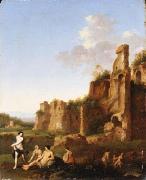 |
Jan van Haensbergen
|
|
(1642-1705) was a Dutch Golden Age painter.
He was registered in the Utrecht Guild of St. Luke in 1668 and in 1669 he was registered in the Confrerie Pictura in The Hague, where he worked until he died.According to Houbraken he was a student of Cornelius van Poelenburgh, and though he was quite successful in imitating his master's style, he switched to portraits since he could make a comfortable living that way.Though he is considered by some to have been born in Utrecht, he signed his name 'Joh. Haensbergh Gorco fecit', which leads historians to conclude he was from Gorinchem. His portraits show the influence of Caspar Netscher. |
|
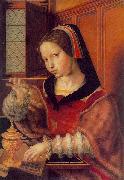 |
Jan van Hemessen
|
|
(c. 1500 - c. 1566) was a Flemish Northern Renaissance painter. He was born in Hemiksem, then called Hemessen or Heymissen. Following studies in Italy, in 1524 he settled in Antwerp. A mannerist, his images focused on human failings such as greed and vanity. Like his daughter, Catarina van Hemessen,he specialised in painted portraits.
Jan Sanders van Hemessen was a Flemish Northern Renaissance painter who was part of the mannerist movement. He was born in Hemessen in the Netherlands but settled in Antwerp in 1524 after studying in Italy. Hemessen specialized in scenes of human character flaws such as vanity and greed.
His pictures are often religious, while his style helped found the Flemish traditions of genre painting. Hemessen was also a portrait painter, which influenced his daughter to become a Flemish Northern Renaissance painter as well. The Surgeon of 1555 is an oil painting by Jan Sanders Van Hemessen currently in the Museo del Prado in Madrid, Spain. The scene likely represents a stonecutter at a fair. The surgeon, who is clearly happy that his operations have been successful, painstakingly moves his knife towards the stone, which is already visible. Behind him hang stones which have been successfully cut out of the head of other patients as a sign of his skill. Next to the quack stands a man who is wringing his hands in desperation, clearly going to be the next patient under the scalpel. |
|
 |
Jan van Huijsum
|
|
also spelled Huijsum, (April 15, 1682, Amsterdam - February 8, 1749, Amsterdam) was a Dutch painter.
He was the brother of Jacob van Huysum, the son of the flower painter Justus van Huysum, and the grandson of Jan van Huysum I, who is said to have been expeditious in decorating doorways, screens and vases. A picture by Justus is preserved in the gallery of Brunswick, representing "Orpheus and the Beasts in a wooded landscape", and here we have some explanation of his son's fondness for landscapes of a conventional and Arcadian kind; for Jan van Huysum, though skilled as a painter of still life, believed himself to possess the genius of a landscape painter.
Half his pictures in public galleries are landscapes, views of imaginary lakes and harbours with impossible ruins and classic edifices, and woods of tall and motionless trees-the whole very glossy and smooth, and entirely lifeless. The earliest dated work of this kind is that of 1717, in the Louvre, a grove with maidens culling flowers near a tomb, ruins of a portico, and a distant palace on the shores of a lake bounded by mountains.
Some of the finest of van Huysum's fruit and flower pieces have been in English private collections: those of 1723 in the earl of Ellesmere's gallery, others of 1730-1732 in the collections of Hope and Ashburton. One of the best examples is now in the National Gallery, London (1736-1737). No public museum has finer and more numerous specimens than the Louvre, which boasts of four landscapes and six panels with still life; then come Berlin and Amsterdam with four fruit and flower pieces; then St Petersburg, Munich, Hanover, Dresden, the Hague, Brunswick, Vienna, Carlsruhe, Boston and Copenhagen. |
|
|
|
|
|
|
|
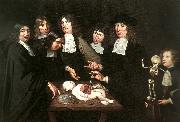 |
jan van neck
|
|
(1634-1714), was a Dutch Golden Age painter. Biography. He was born in Naarden and became a painter, draftsman, engraver, and interior |
|
|
|
|
|
|
|
|
|
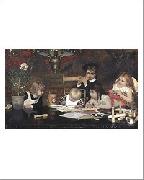 |
Jan Verhas
|
|
(9 January 1834-31 October 1896) was a genre painter and is considered the founder of the School of Dendermonde, best known for his paintings of children of the Belgian bourgeoisie, in a classical style but with a natural feeling to them. Born in Dendermonde as the younger brother of painter Frans Verhas, he studied at the Academy of Dendermonde and the Academy in Antwerp, finishing with the Belgian Prix de Rome in 1860. The Belgian government commissioned him to travel to Venice where he made the painting "Velleda et la Bataille de Callao" in 1862. The next four years, he lived in Binche, where he married. He then moved to Brussels. Verhas was a regular of the Salons of the time, winning a second class medal in the Paris Salon Exposition of 1881, and a gold medal at the 1889 Exposition Universelle. He was made a Chevalier in the Legion of Honor in 1881. Jan Verhas died in Schaarbeek in 1896.
Paintings by Jan Verhas can be seen at the Museum of Fine Arts in Ghent, the Royal Museum of Fine Arts, Antwerp and the City Hall of Dendermonde. |
|
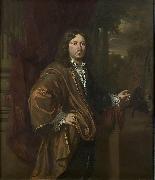 |
Jan Verkolje
|
|
(Amsterdam, baptized on 27 February 1650 - Delft, 8 May 1693) was a Dutch Golden Age painter and engraver, often called Jan I to distinguish him from his son Jan II. He is known for his portraits and genre pieces.
|
|
|
|
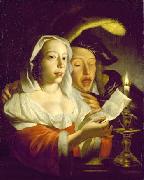 |
Jan Vermeer van Utrecht
|
|
(bapt. 16 February 1630, Schipluiden - c. 1696, Vreeswijk), was a Dutch Golden Age painter. Though he was born near Delft, there is no known relation between this painter and Johannes Vermeer.
His father died when he was 10 and he was raised by his step-grandfather in Rotterdam. According to Houbraken he travelled to Italy with Lieve Verschuier and became friends with Willem Drost and Johann Carl Loth.
He returned North in 1662, where he became member of the Utrecht Guild of St. Luke in 1663 and became deacon of the guild 1664-1666.Houbraken tells a curious story about Vermeer van Utrecht in his biography of Jan Davidsz de Heem. In this story, on his return from Italy, Vermeer marries a widow who owns a white lead factory. He is wealthy and has a carefree life until his wife dies and then his factory is burned by French soldiers. He manages to save a garland painting by De Heem that he once paid 2000 guilders for. This was an enormous sum of money, but Houbraken mentions that his grandfather had been a wealthy man, and until his factory was destroyed, Vermeer van Utrecht had been painting for pleasure, rather than professionally. The amount is meant as an indication of the fame and esteem of De Heem, rather than the wealth of Vermeer van Utrecht. Vermeer van Utrecht then applies to his benefactor, Frederick Nassau de Zuylestein, to give him a government post in return for this painting, which he offers to paint with the likeness of the young prince Willem III in the middle of the garland. The lord of Zuylestein was the governor of the young prince from 1659 to 1666, so this deal must have been done sometime between 1662 (Vermeer van Utrecht's return from Italy), and 1672 (the death of the lord of Zuylestein). Apparently, the deal is done, and several years pass, in which Vermeer van Utrecht did become an appointed member of the Utrecht regency (Vroedschap), but where he felt like a fifth wheel. In 1672 the Utrecht council takes pity on him, and gave him the post of Toll-collector and controller of the river lock at Vreeswijk, where he later remarried. |
|
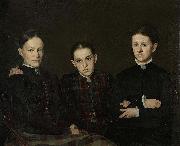 |
Jan Veth
|
|
(18 May 1864 Dordrecht - 1 July 1925 Amsterdam), was a Dutch painter, poet, art critic and university lecturer.
Jan Veth was the son of Gerradus Huibert Veth, a Dordrecht iron merchant and liberal politician, and Anna Cornelia Giltay. On his mother's side he descended from the Dordrecht painter family of Van Strij (his mother was a granddaughter of Jacob van Strij). He married Anna Dorothea Dirks on 10 August 1888, from which marriage came five children.
Veth received his art education at the Rijksakademie voor Beeldende Kunsten in Amsterdam. With several of his fellow students he founded the St. Luke group. From 1885 he worked with the painter Anton Mauve in Laren. After his marriage in 1888 he settled in Bussum.
Jan Veth is especially noted as a portrait painter. Amongst his sitters were Max Liebermann, Lambertus Zijl, Frank van der Goes, Antoon Derkinderen and other contemporaries including various fellow painters.
In addition he was a well-known poet, belonging to the Eighties movement and publishing work in the De Nieuwe Gids. He designed the cover for "De Kleine Johannes", a book written by his friend, Frederik van Eeden, contributing to the development of book-art in Holland.
As Professor Extraordinary in History of Art and Aesthetics, he was associated with the Rijksakademie voor Beeldende Kunsten in Amsterdam.
|
|
|
|
|
|
|
|
|








